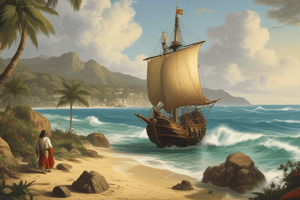Podcast
Questions and Answers
What are some popular novels by R K Narayan?
What are some popular novels by R K Narayan?
The Return of the Native, Mayor of Casterbridge, Tess of the d’Urbervilles
What was the setting for most of R K Narayan's stories and novels?
What was the setting for most of R K Narayan's stories and novels?
Malgudi
What are some characteristics of the Victorian novelists according to the text?
What are some characteristics of the Victorian novelists according to the text?
They were spokesmen of their age, reflected social conditions, portrayed tensions of their time, explored social conditions of children, emphasized respectability, presented bad educational systems, and varied in settings and language.
Which Victorian novelist explored the unjust treatment of childhood in their work?
Which Victorian novelist explored the unjust treatment of childhood in their work?
What was central in most of the Victorian novels according to the text?
What was central in most of the Victorian novels according to the text?
What theme is presented in novels like Jane Eyre and Hard Times?
What theme is presented in novels like Jane Eyre and Hard Times?
What is the characteristic of language in Victorian novels according to the text?
What is the characteristic of language in Victorian novels according to the text?
Which Indian author created a society called Malgudi?
Which Indian author created a society called Malgudi?
What is the title of a popular novel by R K Narayan?
What is the title of a popular novel by R K Narayan?
What kind of settings were presented in Victorian novels?
What kind of settings were presented in Victorian novels?
Flashcards are hidden until you start studying
Study Notes
Elements of the Modern Novel
- Modern novels encompass settings, characters, and conflicts that guide the protagonist, Christian, through themes like repentance, faith, temptation, and perseverance.
- The narrative structure includes essential components: beginning, conflict, rising action, falling action, and resolution.
- Bunyan's "Pilgrim's Progress" serves as a key model for storytelling, featuring vivid characters and dialogues that influenced subsequent novelists.
Definition and Origin of the Term "Novel"
- A novel is defined as a fictitious prose narrative of significant length, showcasing characters and actions representative of real life in a complex plot.
- The term "novel" derives from:
- Latin: Novellus
- Italian: Novella (meaning "little new thing")
- French: Nouvelle
- Boccaccio coined the term "novella storia" to signify short prose tales, marking early experimentation with the genre.
Rise of the Middle Class
- The Industrial Revolution led to the emergence of a wealthy middle class, driven by industrial and commercial growth.
- This new socio-economic group demanded literature, as more individuals, including women, gained access to education and reading.
- The middle class favored stories about common people over traditional medieval tales, influencing novel themes.
- Notable novels appealing to this audience include Daniel Defoe's "Robinson Crusoe," Samuel Richardson's "Pamela," and Henry Fielding's "Tom Jones."
Mobile Libraries
- The introduction of mobile libraries contributed significantly to the rise in readership by providing easy access to books at home.
- Popular works by Jane Austen, such as "Pride and Prejudice" (1796), "Sense and Sensibility" (1797), and "Mansfield Park" (1814), emerged during this period of increased accessibility to literature.
Historical Novels
- Sir Walter Scott pioneered the historical novel genre, blending historical settings with lively narratives.
- His works, including "Rob Roy" (1817) and "Ivanhoe" (1820), brought a vital energy to historical storytelling.
Chronicle Novels
- Chronicle novels, like Jane Austen's "Emma" (1815) and Charlotte Brontë's "Jane Eyre" (1847), narrate events from early childhood to adulthood, emphasizing chronological connections.
Gothic Novels
- Gothic novels employ elements of horror and the supernatural, featuring ghosts, tombs, and dungeons.
- The first gothic novel, "The Castle of Otranto" (1764) by Horace Walpole, launched the genre, followed by Emily Brontë’s "Wuthering Heights" (1847), which includes the ghost of Catherine.
Regional Novels
- The regional novel genre, attributed to Thomas Hardy, portrays distinct geographical settings and cultural elements.
- Hardy created the fictional region of Wessex, forming the backdrop for many of his narratives, thus labeling them as "Wessex novels."
Studying That Suits You
Use AI to generate personalized quizzes and flashcards to suit your learning preferences.




